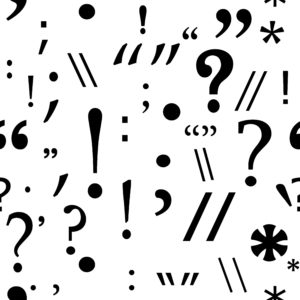
I mentioned previously that my husband and I have sons who are twins, but unfortunately I didn’t have space in that post to talk more about them. They’re grown up now (I can’t believe they’ll be 30 in July!) but raising them was quite an experience. We gave them similar names, and they look a lot alike, though not as much now as when they were kids. Yet despite having many common interests, they have distinctly different personalities.

Which brings us to the latest installment of our punctuation survey: the colon and the semicolon, which would seem to be the twins of the punctuation world. Like our sons, they have similar names. And each is made up of two other punctuation marks: a colon is two periods stacked up, while a semicolon is a period over a comma. But despite the similarities, colons and semicolons are used very differently.
First, a quick grammar definition which will help with the following explanations. Remember that for a string of words to be considered a complete sentence, it needs a subject (an actor) and a verb (an action or a linking word). Another name for a sentence is an independent clause:
Scientific researchers often use identical twins as subjects.
I can’t imagine what it would be like to have triplets or more.
Some cultures consider the birth of twins to be good luck.
Be on the lookout—you might see some of these independent clauses again soon. And now that we have that out of the way, let’s get started.
The easiest way to remember what a colon does it to think of it as meaning “as follows.” You can use one at the end of an independent clause to indicate that the words following will explain, illustrate, or amplify what you said before the colon. The material after the colon can be another sentence or a list:
Scientific researchers often use identical twins as subjects: their matching DNA profiles allow the scientists to control for one variable.
Parents need three attributes for raising twins: flexibility, a positive attitude, and endless patience.
And as a matter of fact, you can even include the words “as follows,” or other such introductory words, before a colon:
I always give new parents of twins the following advice: don’t sweat the small stuff, and remember that most of it is small stuff.
Just one caution with the colon: always remember that it should come after an independent clause—that is, a compete sentence. Don’t use a colon when you have a list within a sentence:
Incorrect: Our sons’ common interests are: languages, video games, and martial arts.
This is incorrect because the bit before the colon—Our sons’ common interests are—is not a complete sentence without a complement after the linking verb are. Here’s how it should look:
Correct: Our sons’ common interests are languages, video games, and martial arts.

While the colon is pretty straightforward, the semicolon can be a bit trickier because its use is often optional. Some writers love it, while others never use it at all. For hardcore grammar nerds (like me) there’s even a whole book about the use and abuse of the semicolon throughout the history of English literature and prose. (I am not an Amazon affiliate and do not receive anything for this endorsement.)
So let’s take it one step at a time. The easiest way to use a semicolon is to join two independent clauses without a joining word (conjunction) when the writer wants to make a close connection between them:
Raising twins wasn’t easy; I can’t imagine what it would be like to have triplets or more.
Identical twins share 100% of their DNA; fraternal twins share just 50%, the same as regular siblings.
In both these cases you can see why the writer would opt to link the independent clauses; they are clearly related. But you could instead join them with a comma and a conjunction (for, and, nor, but, or, yet, or so):
Raising twins wasn’t easy, so I can’t imagine what it would be like to have triplets or more.
Identical twins share 100% of their DNA, but fraternal twins share just 50%, the same as regular siblings.
Or you could make them two separate sentences:
Raising twins wasn’t easy. I can’t imagine what it would be like to have triplets or more.
Identical twins share 100% of their DNA. Fraternal twins share just 50%, the same as regular siblings.
So this is a stylistic choice. All these options are grammatically acceptable, but each has a different feel to it. To me, the last option—making them two sentences—seems choppy. But sometimes that might be the effect you want to create.
You can also include an introductory word or phrase after the semicolon and before the second sentence. Words and phrases commonly used in this situation include however, therefore, indeed, thus, hence, accordingly, besides, that is, for example, namely, etc. Be sure to include a comma after the introductory word or phrase and before the second sentence:
Some cultures consider the birth of twins to be good luck; however, others regard it as a bad omen.
Our sons have rather different personalities; nevertheless, they are very close.
The last main use of the semicolon is for a series of phrases which contain internal punctuation, usually commas. (And yes, I couldn’t resist sneaking in more colons as well):
My mother-in-law sewed many wonderful things for the boys: their white, traditional christening gowns; little sports coats in their customary colors—one red, one blue; and several Halloween costumes.
Our sons had an interesting assortment of possessions growing up, such as: sturdy, slanted drawing boards; comfortable, black, waterproof boots for playing outside; and a vast collection of Lego blocks.
Once again, this is not mandatory; if the list is unambiguous punctuated with commas, you can do it that way instead:
Our sons had an interesting assortment of possessions growing up, such as: sturdy, slanted drawing boards, comfortable, black, waterproof boots for playing outside, and a vast collection of Lego blocks.

Currently the boys live in separate states and can get together only every few months. Since I can’t reunite them right now, I’m going to at least get the punctuation twins back together. The one remaining similarity between the colon and the semicolon is that they are both placed outside quotation marks and parentheses:
Here’s an interesting fact about the two members of the 80s group The Proclaimers, whose one big hit was “I’m Gonna Be”: they are identical twin brothers.
My mother-in-law sewed many wonderful things for the boys: their white, traditional-style christening gowns; little sports coats in their customary colors (one red, one blue); and several Halloween costumes.
Hopefully this has helped demystify the colon and semicolon at least a little bit—but please feel free to contact me at steph@tightprose.com if you have any questions! They’re really not so daunting, and remember too that a semicolon is usually optional. If you choose to join the ranks of those who don’t use it, you’ll be in good company with writers such as George Orwell and Kurt Vonnegut, to name just…two!
